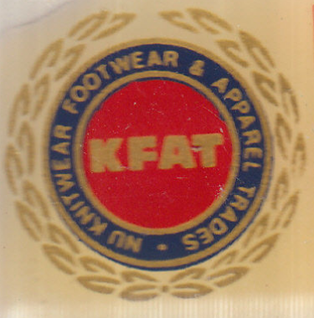Related Research Articles

The National Union of Knitwear, Footwear and Apparel Trades (KFAT) was a trade union in the United Kingdom.
Community is a UK trade union which formed in 2004. The union represents workers in a diverse range of sectors, including iron and steel, domestic appliance manufacturing, clothing, textiles, footwear, road transport, betting and gaming and call centres, as well as workers in voluntary organisations, workshops for visually impaired and disabled people, community-care providers and housing associations. Although the former trade unions which amalgamated to form Community were all craft unions or industrial unions, Community is now a general union. Community has merged or transferred engagements with a number of smaller unions, some of which have become sections within Community. These include the National League of the Blind and Disabled (NLBD), the National Union of Domestic Appliance and General Operatives (NUDAGO), the National Union of Knitwear, Footwear & Apparel Trades (KFAT), the British Union of Social Work Employees (BUSWE), the Prison Service Union and the UFS.

The General Federation of Trade Unions (GFTU) is a national trade union centre in the United Kingdom. It has 35 affiliates with a membership of just over 214,000 and describes itself as the "federation for specialist unions".

The National Union of Hosiery and Knitwear Workers (NUHKW) was a trade union in the United Kingdom.
N. Corah and Sons was a manufacturer of hosiery and textiles, located in Leicester in the United Kingdom. At one time it was the largest knitwear producer in Europe, and its products had a major influence on the development and prosperity of the Marks & Spencer chain of retail stores.
The General Council of the Trades Union Congress is an elected body which is responsible for carrying out the policies agreed at the annual British Trade Union Congresses (TUC).
The Amalgamated Society of Operative Lace Makers and Auxiliary Workers, also known as the Lace Makers' Society, was a trade union representing laceworkers in England.
Robert Bryce Stevenson was a British trade unionist.
Horace Matthew Moulden-Colton was a British trade union leader.
George Edmund Dearing was a British trade union leader.
Harold Leslie George Gibson was a British trade union leader.
Helen Frances McGrath was a Scottish trade unionist.
The Scottish Lace and Textile Workers' Union was a trade union representing textile workers in Scotland.
The Rochdale and District Weavers', Reelers', Beamers' and Doublers' Association was a trade union representing cotton industry workers in Rochdale and surrounding areas of Lancashire in England.
The Leicester and Leicestershire Amalgamated Hosiery Union was a trade union representing machine knitters in Leicestershire.
The Nottingham and District Hosiery Workers' Society was a trade union representing machine knitters in and around Nottingham, in England.
Clifford Groocock Groocock was a British trade union leader.
The Notts Trades Council, formally known as the Nottinghamshire Nottingham and Mansfield Trades Council, brings together trade unionists in Nottinghamshire, in England.
The Hinckley and District Hosiery Union was a trade union representing workers involved in making hosiery in the Hinckley area of Leicestershire, in England.
The Nottingham Hosiery Finishers' Association (NHFA) was a trade union representing workers involved in trimming and putting together hosiery in the Nottingham area of England.
References
- 1 2 3 Marsh, Arthur; Ryan, Victoria; Smethurst, John B. (1994). Historical Directory of Trade Unions. 4. Farnham: Ashgate. p. 377. ISBN 9780859679008.
- 1 2 Gurnham, Richard (1976). A History of the Trade Union movement in the Hosiery and Knitwear Industry. Leicester: National Union of Hosiery and Knitwear Workers. pp. 117–119.